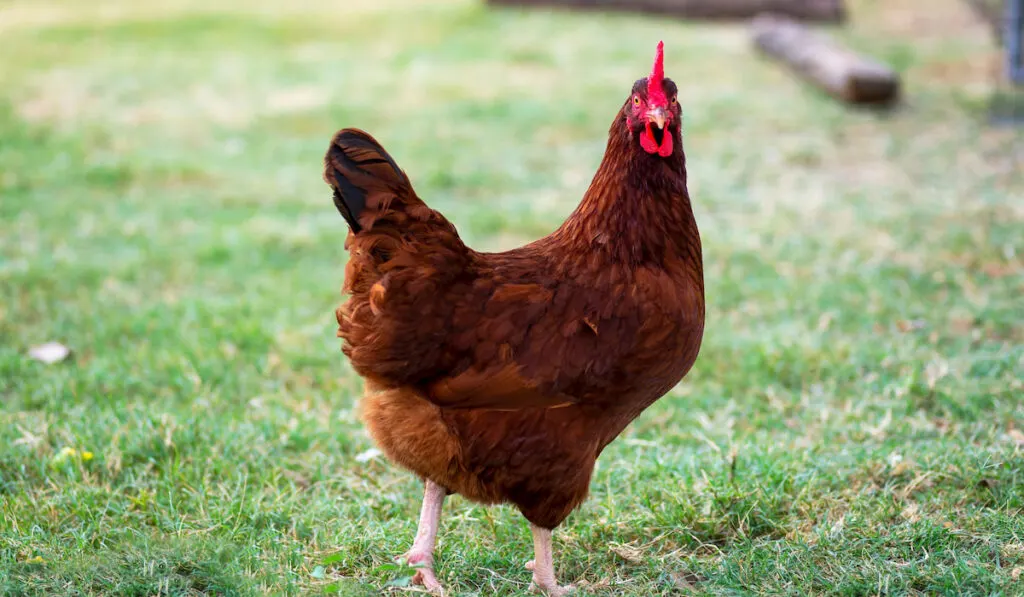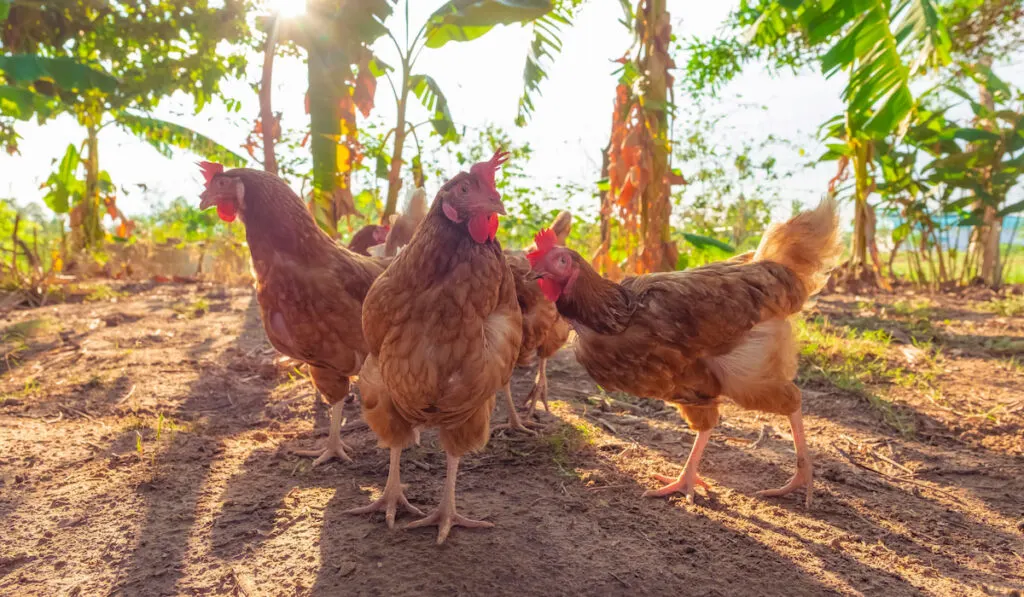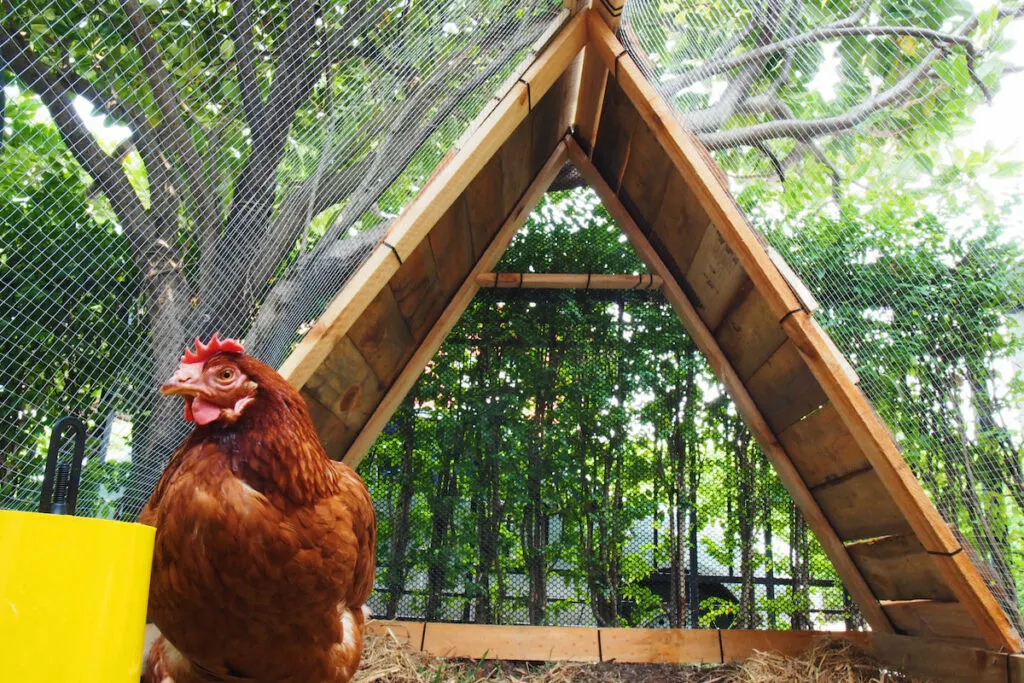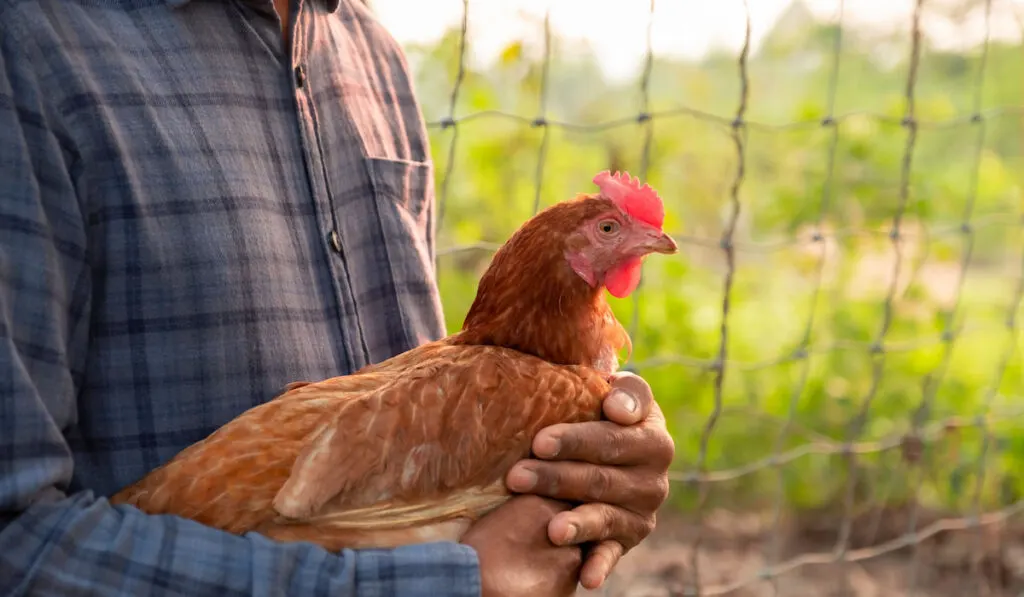The Rhode Island Red is a beautiful and hardy breed of chicken that originated in the US state of Rhode Island in the late 1800s. Known for its striking red-brown feathers, calm demeanor, and ability to produce large numbers of eggs over its lifetime, the Rhode Island Red has become a popular breed for farmers and backyard enthusiasts.
This article closely examines the history, characteristics, and other interesting facts about Rhode Island Red.

Table of Contents
History
Rhode Island Red Breed was developed in Rhode Island, as the name suggests. The breed originated from Malay, Shanghai, Java, and Brown Leghorn chickens. As the story goes, a sea captain named William Tripp brought a Malay rooster to his hometown and bred it with his chickens.
The offspring were more fertile and laid more eggs, around 200- 300 eggs per year, beginning at the age of just six months. He then partnered with his friend to continue crossbreeding with several other varieties of chickens.
When a nearby poultryman, Issac Wilbour, heard of these superior foul varieties, he started his selection process by buying some of them from Tripp and his partner. Wilbour is the one who founded the Rhode Island Red. Soon the demand for this breed increased exponentially, as did its popularity.
It was included in the American Poultry Association Standard of Perfection in 1904. Later, in 1954, it was elected as the state bird of Rhode Island. Moreover, two statues of Rhode Island Reds were instilled in two separate places, Adamsville and Little Compton.

Appearance
| Characteristic | Rhode Island Red |
| Color | Rusty brown with black tail (baby chicks are light brown to tan in color) |
| Weight | Males: 8.5 lbs. Females: 6.5 lbs. |
| Lifespan | 8 to 9 years |
| Height | 27 inches on average |
| Noisy | Yes |
| Suited for Hot Climate | Yes |
| Egg Color | Light brown |
| Egg Production | 5-6 weekly |
| Child-Friendly | Hens (Yes), Roosters (No) |
The modernized Rhode Island Red has a distinct plumage color that differentiates it from the original breed, which has a deep, red, mahogany-like color. Interestingly, chicks brooded in an incubator have a lighter, rust-like red color.
Rhode Island Red chicks have beautiful rusty down with dark lines on their backs, which change into different black and rust patterns as the birds mature.
A full-grown hen weighs 6.5 pounds, while the rooster weighs 8.5 pounds. Their color is usually dark, ranging from red to brown, with black tails. Rhode Island Reds have yellow legs, orange eyes, and brown beaks. The roosters have only a single comb.

Temperament
The usual Rhode Island Red is considered rather vocal and ‘loudmouthed.’ This is noted by most farmers, with some even terming them ‘annoying.’ However, this trait isn’t something that is widely listed in breed profiles. It can be something to consider if you are in close quarters with neighbors.
They are usually a very active breed, always scavenging for bugs. Their curious nature makes them rather free-spirited. Hens are considered docile and slow, whereas the roosters are the more lively and aggressive ones and can be especially protective of the chicks.
Rhode Island Reds usually have a low cold tolerance but a moderate-good heat tolerance. The species is not considered too broody and can tolerate confinement well, along with evading predators.
Health
Most Rhode Island Reds are known for their sturdy nature and do not fall sick easily. However, some common diseases that can affect the birds are:
Bird flu (Avian influenza):
This disease is caused by influenza and has a 100% death rate, spreading through the respiratory tract. It has the potential to circulate from one chicken to the other, quickly overtaking the entire flock of birds. The birds not only become lazy but also lay fewer eggs.
Vitamin A deficiency:
This deficiency results in chicks with weak, yellow legs and beaks and shaking heads. Unlike the previous disease, which had a high death rate, this disease can easily be treated with a vitamin A-rich diet.
Fainted paws:
Vitamin B2 deficiency results in birds with paws turned inside, disabling them. It is known as fainted paws and can be avoided by vitamin B2 supplements.
Chickenpox:
This contagious disease affects birds of all ages and causes sores around the eyes, ears, and comb. The infectious nature also passes from dead chickens to humans and can manifest this disease among people. The recommended treatment includes Antimonium Tartaricum drug administration.
Ranikhet disease:
Also called New Castle disease, RD is a rapidly spreading illness that creates breathing problems among birds. It dramatically shortens their lifespan and can cause adverse effects for poultry farmers as entire flocks are affected. The only possible treatment is the administration of vaccines.
Leucosis and Marek’s:
Another contagious disease is Leucosis and Marek’s disease, which results in fainted legs and grey-colored eyes, often accompanied by blindness.

Use
Rhode Island Reds are popular for both their eggs and their meat. The 200 to 300 egg range per year makes them a suitable breed for farmers. They are among the best dual-purpose heavy chicken breeds in the world.
Larger hens lay larger eggs as they grow bigger. Egg laying is unaffected by the hot or cold climate, but their combs are susceptible to frostbite at lower temperatures.
The meat of Rhode Island Red is considered to have a richer flavor than most chickens. They reach butcher size roughly around the age of 4-5 months, which is far longer than other breeds, such as the Cornish Cross (around 8-10 weeks).

Care and Maintenance
While the full-grown breed does not require intensive care, newborn chicks require attention and time. After hatching, the chicks must be delicately handled and kept for brooding at a fixed temperature of 95⁰F for a week while continuously providing fresh water and specialized feed.
Feeding
Adult Rhode Island Red requires around ¼ lb. of high-quality 16% layer feed daily. However, they are excellent foragers and will find food for themselves. Ensure that there is extra calcium in the food pellets, which aids in laying stronger and better eggs.
Young chicks require good-quality chick feed for the initial few weeks of their life. After the age of 16 weeks, these chickens are ready to be transitioned to layer feed.
Vaccination

The vaccination process for chicks is incredibly crucial. The following schedule is suggested for preventing and halting the spread of contagious diseases:
- HVT vaccine to one-day-old chick
- RD vaccine for 4–7-day-old chicks
- IBD vaccine for 18–21-day old chicks
- RD vaccine again at 6-8 weeks and then at 8-10 weeks
Conclusion
The Rhode Island Red breed is popular for its egg-laying ability as well as its exceptional beauty. They were initially founded by multiple crossbreedings and hence possess the traits of various birds.
The high egg count and the rich meat flavor are the qualities of the Rhode Island Red breed. Proper vaccination, care, and feed are required to ensure these feathery animals remain in perfect health.
Resources
- https://livestockconservancy.org/heritage-breeds/heritage-breeds-list/rhode-island-red-chicken/
- https://backyardpoultry.iamcountryside.com/chickens-101/the-history-of-rhode-island-red-chickens/
- https://www.thehappychickencoop.com/rhode-island-red/
- https://www.mannapro.com/homestead/bid/145273/chicken-breeds-spotlight-rhode-island-reds
- https://www.thefeatherbrain.com/blog/rhode-island-red-chickens
- https://www.apnikheti.com/en/pn/livestock/chicken/rhode-island-red-r-i-r
- https://thehensloft.com/how-big-do-rhode-island-reds-get/
- https://www.mychickenguide.com/rhode-island-red/
- https://www.thespruce.com/chicken-breeds-rhode-island-red-3016554
- https://www.knowyourchickens.com/rhode-island-red-chicken/
